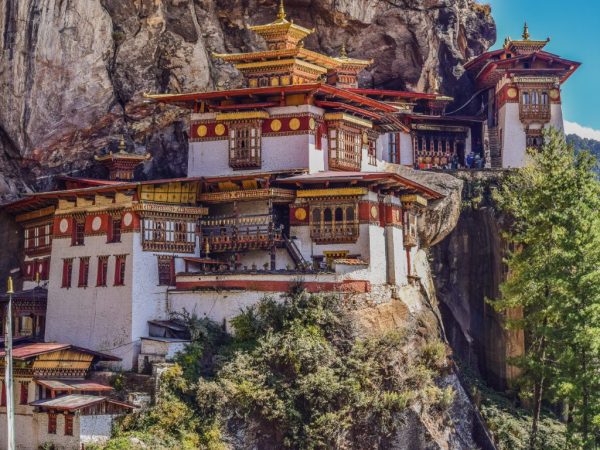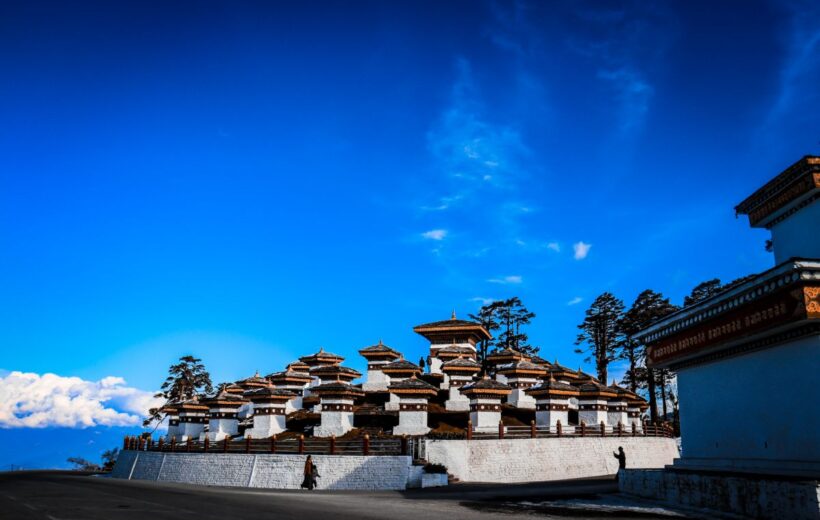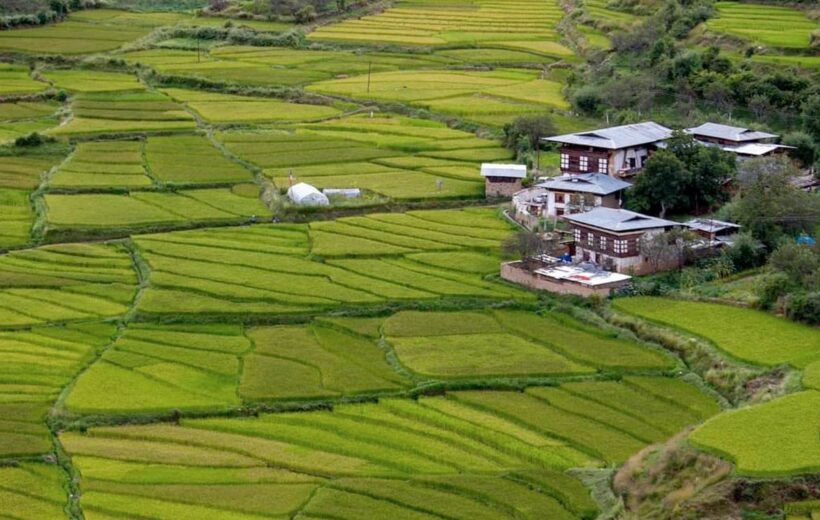Overview
Bhutan is divided into twenty districts, six of which are in the eastern part of the country: Trashigang, Trashi Yangtse, Mongar, Lhuentse, Samdrup Jongkhar, and Pema Gatshel. The eastern region sees far fewer tourists compared to the western regions, making it a perfect destination for those seeking a quieter and more authentic experience. Adventurous travelers venturing east will find uncrowded dzongs and temples, beautiful silks and embroidery, and lush forests teeming with birds.
Although food and accommodation options are modest and simple, reflecting the region’s remoteness, the eastern part of Bhutan is surprisingly densely populated. Many residents live in remote settlements high above the roads or in isolated valleys. While the east is gradually opening up to tourism, it remains a frontier for adventure travel in Bhutan.
Included/Excluded
- The Bhutan SDF
- All accommodations
- Meals and mineral water
- A licensed English-speaking guide
- A driver and vehicle
- Air fare
- A visa fee of US$40
- Alcohol
- Gifts/Souvenirs
- Travel insurance and personal bills
- Museums & Monument Fees
Tour Plan
Day 1: Arrival in Paro
- Flight to Paro: On a clear day, enjoy a spectacular flight with views of major Himalayan peaks including Everest, Kanchenjunga, Makalu, Chomolhari, Jichu Drake, and Tserimgang.
- Arrival: Experience Bhutan’s cool, clean fresh mountain air upon disembarkation. You will be met by your Bhutan representative and transferred to your hotel.
- Afternoon: Free for leisure or activities.
- Evening: Stroll around Paro market after dinner.
- Overnight: Hotel in Paro.
Day 2: Tiger's Nest Hike
- Morning:
- Taktshang (Tiger's Nest): Hike to the famous cliff-hermitage. Enjoy the trail through pine forest and prayer flags. Have lunch at the Cafeteria on your way back.
- Afternoon:
- Ta Dzong: Visit the National Museum housed in a former watchtower.
- Paro Dzong: Explore Rinpung Dzong, built in 1646, which now houses Paro’s monk body and civil administration offices.
- Drukgyel Dzong: Visit the ruins of the Fort of Drukpa Victory.
- Kyichu Lhakhang: Visit one of Bhutan’s oldest shrines.
- Overnight: Hotel in Paro.
Day 3: Paro to Thimphu
- Morning:
- Drive to Thimphu, passing through idyllic countryside with villages and paddy fields.
- Thimphu Dzong: Attend the Festival showcasing sacred dances.
- Simtokha Dzong: Visit one of Bhutan's oldest fortresses.
- Afternoon:
- Tashichhodzong: Visit the seat of the government.
- National Memorial Chorten: Explore the chorten with fine wall paintings and statues.
- Buddha Point: Visit the large Buddha statue.
- Handicrafts Emporium: Browse traditional handicrafts.
- Archery Ground: Watch a game of archery if available.
- Evening: Stroll around Thimphu market.
- Overnight: Hotel in Thimphu.
Day 4: Thimphu to Punakha
- Morning:
- National Library: Explore the extensive collection of Buddhist manuscripts.
- Institute for Zorig Chusum: Visit the Painting School.
- National Institute of Traditional Medicine: View from outside.
- Afternoon:
- Drive to Punakha across Dochu-la pass (3,088m/10,130ft) with views of the eastern Himalayas.
- Punakha Dzong: Visit the impressive dzong situated at the junction of Pho Chu and Mo Chu rivers.
- Overnight: Hotel in Punakha.
Day 5: Punakha to Gangtey (Phobjikha) to Throngsa
- Morning:
- Drive to Wangdu, then up a mountain road through forest and over a pass into the Phobjikha valley.
- Phobjikha Valley: Explore the glacial valley, home to black-necked cranes in winter.
- Gangtey Gompa: Visit the only Nyingmapa monastery in western Bhutan.
- Afternoon:
- Continue exploring Phobjikha valley, then drive to Tongsa via Pele-la pass (3,300m/10,830ft).
- Chendebji Chorten: Visit the stupa built in the Nepalese style.
- Overnight: Hotel in Tongsa.
Day 6: Tongsa to Bumthang (Jakar)
- Morning:
- Tongsa Dzong: Visit the impressive dzong.
- Ta Dzong: Explore the watchtower.
- Afternoon:
- Drive to Bumthang via Yutong-la pass (3,400m/11,155ft).
- Explore Chumey valley.
- Overnight: Hotel in Bumthang.
Day 7: Bumthang Exploration
- Morning:
- Kurje Lhakhang: Visit the sacred site where Guru Rinpoche meditated.
- Jambey Lhakhang: Visit the 7th-century temple.
- Afternoon:
- Tamshing Lhakhang: Visit the 1501 festival site.
- Jakar Dzong: Explore "the castle of the white bird".
- Stroll through Bumthang’s market.
- Overnight: Hotel in Bumthang.
Day 8: Bumthang to Mongar
- Morning:
- Drive to Mongar, passing through rugged terrain and high passes.
- Thrumsing-la Pass: Enjoy views from Bhutan’s highest motorable road point.
- Afternoon:
- Mongar Dzong: Visit the dzong built in the 1930s.
- Overnight: Hotel in Mongar.
Day 9: Mongar to Tashigang
- Morning:
- Drive to Tashigang via Kori-la pass (2,450m/8,040ft).
- Drametse: Visit the temple and monastery.
- Afternoon:
- Tashigang Dzong: Explore the administrative and monastic site.
- Overnight: Hotel in Tashigang.
Day 10: Tashigang to Tashiyangtse
- Morning:
- Gom Kora: Visit the temple.
- Doksum Village: Observe traditional weaving.
- Afternoon:
- Tashiyangtse: Explore the growing town, Dzong, Chorten Kora, and Institute for Zorig Chusum.
- Overnight: Hotel in Tashigang.
Day 11: Tashigang to Bumthang
- Travel: Return to Bumthang via the same route.
- Overnight: Hotel in Bumthang.
Day 12: Bumthang to Thimphu
- Travel: Drive back to Thimphu.
- Overnight: Hotel in Thimphu.
Day 13: Thimphu to Haa
- Morning:
- Drive to Haa Valley, known for its pristine alpine forests and tranquil peaks.
- Explore the valley, visiting local temples and enjoying hiking or mountain biking.
- Overnight: Hotel in Haa.
Day 14: Haa to Paro via Chela Pass
- Morning:
- Lhakhang Kharpo and Nagpo: Visit the White and Black Chapels.
- Afternoon:
- Cheli la Pass: Enjoy views of Mt. Jumolhari, Jichu Drake, and surrounding peaks.
- Kila Gompa Nunnery: Hike to the nunnery established in the 9th century.
- Overnight: Hotel in Paro.
Day 15: Departure
- Morning: Depart from Paro.
This itinerary offers a comprehensive exploration of Bhutan's rich cultural heritage, breathtaking landscapes, and unique traditions, providing an unforgettable experience for any traveler.
Tour Map
FAQ
Bhutan is a year-round destination. There are four seasons: summer (June to August), autumn (September to November), winter (December to February) and spring (March to May). But because of the range of altitudes in the country, and the influence of the north Indian monsoons, the climate is incredibly varied.
In the south, the humid, subtropical climate is fairly consistent year-round, with temperatures between 15oC and 30oC. Central Bhutan, with its temperate forests, has a more seasonal climate, with warm summers and cool, dry winters. The northern regions are much colder during winter. Because of the high altitude, mountain peaks are snowy year-round and the lower reaches remain cool in summer.
In summer, the Indian monsoon season runs from late June or July to late September, mostly affecting the southern regions. Most farming activities take place in the summer, when crops thrive in verdant landscapes.
Autumn, from late September or early October to late November, follows the rainy season. It is characterised by bright, sunny days and some early snowfall at higher elevations. It’s the season of feasts and festivals as farmers reap the fruits of their work.
From late November until March, the crisp, clear and sunny winter sets in, with frost throughout much of the country and snowfall common above elevations of 3,000 metres. The winter northeast monsoon brings gale-force winds at the highest altitudes through high mountain passes, giving Bhutan the name Drukyul, which means Land of the Thunder Dragon in Dzongkha (Bhutan’s national language).
Bhutan’s generally dry spring starts in early March and lasts until mid-April. It is a botanist’s delight, with nature in full bloom. Summer weather commences in mid-April with occasional showers and continues to late June.
The SDF is USD 100 per night for adults from all countries except for India. Children aged between 6 years and who have not yet turned 12 are eligible to pay USD 50 per night. Children who have not yet turned 6 years old do not have to pay any SDF.
The SDF for Indian nationals (showing a valid Indian passport or Voter ID card) is Nu. 1,200 (or the equivalent amount in Indian rupees) per person, per night. Children aged between 6 years and who have not yet turned 12 are eligible to pay Nu./INR 600 per night. Children who have not yet turned 6 years old do not have to pay any SDF.
While most monuments in Bhutan are free, some are chargeable. For the full list of monument fees, please click here for more information. Children below 18 years will have a 50% concession and children aged five years and below will be exempted. Most monuments are open from 9am – 5pm each day. In June 2023 it was announced that foreign visitors can now visit monuments whenever they are open to the general public, without any restrictions.














